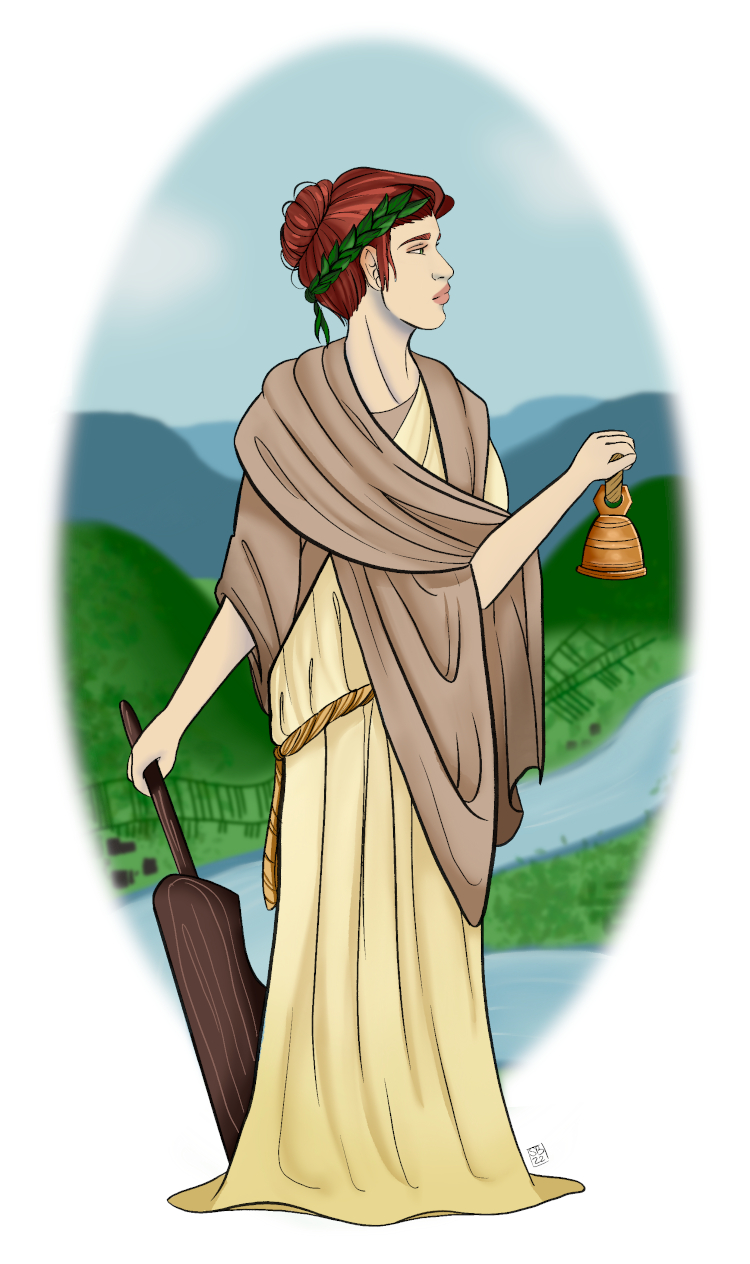SVLEVIIS: to the SULEVIÆ
While low-key, the Suleviæ are nevertheless quintessential (Germano?-)Celtic goddesses. Their name is to be interpreted as ‘good rulers’ or ‘good guides’;Xavier Delamarre (2003). Dictionnaire de la langue gauloise. Errance, p. 286. In the original, “bonnes dirigeantes”, “bonnes guides”. it is made up of the prefix su- ‘good’The Gaulish prefix su- corresponds to the Greek eu- —both mean ‘good’ or ‘well’ (and thus the Greek name Εὐγένιος or Eugene, for example, means ‘well-born’). The same Gaulish prefix is to be found in Sucellus, the ‘good striker’. and the root leuia, related for example to the Welsh llywydd ‘leader’.Nicole Jufer & Thierry Luginbühl (2001), Les dieux gaulois : répertoire des noms de divinités celtiques connus par l'épigraphie, les textes antiques et la toponymie. Errance, pp. 15, 64. Over forty votive inscriptions in their honour are knownHere is the list (plain text), which I’ve drawn from the Epigraphik Datenbank Clauss-Slaby (accessed 10 January 2015). across an area stretching from Great Britain to Pannonia, with a particular concentration in Germania Superior (today’s Baden, Palatinate, Alsace and especially Switzerland). They are most often invoked in the plural (Sule(u)iis or even Suleuiabus, 41 inscriptions), but there are also some invocations in the singular (Suleuiae, 3 inscriptions).

A modern depiction of Sulevia. The rudder—a common attribute of Fortuna—references the ‘good helmswoman’ etymology, while the bell has relevance at once to domestic life, purification rites, and a montane environment.
(Artwork © Nesquidly)
The most noteworthy worshippers of the Suleviæ are the Equites Singulares Augusti (‘Emperor’s Own Horseguard’), many of whom were drawn from the Romano-Celtic provinces.This regiment also actively participated in other religious cults of interest to us, such as those of Epona and Jupiter Optimus Maximus Dolichenus. This élite cavalry unit left 13 inscribed monuments in Rome that mention the Suleviæ. Most often this is done as part of a series of deities, most of whom can be recognized as the leading gods and goddess of Roman Gaul: Iovi Optimo Maximo Ivnoni Minervae Marti Victoriae Hercvli Fortvnae Mercvrio Felicitati Salvti Fatis Campestribvs Silvano Apollini Dianae Eponae Matribvs Svlevis et genio singvlarivm Avg ceterisq dis immortalibvs, ‘to Jupiter Best and Greatest, Juno, Minerva [the deities of the Capitoline Triad], Mars, Victoria, Hercules, Fortuna, Mercury, Felicity, Salus, the Fates, the Campestres, Silvanus, Apollo, Diana, Epona, the Matronæ, the Suleviæ and the genius of the Equites Singulares Augusti as well as the other undying gods ».These deities appear in virtually the same order on nine monuments: Corpus Inscriptionum Latinarum (CIL) vi: 31140, 31141, 31142 31145, 31146, 31148, 31149, 31174 and 31175. One of these inscriptions leaves out Hercules and Fortuna (CIL vi: 31141), another omits only Hercules (CIL vi: 31142), and yet another omits only Fortuna (CIL vi: 31174), while one invokes the Fates ahead of Salus (CIL vi: 31148). Other variations concern only spelling or abbreviations. This clearly is a standard ‘pantheon’ of the Equites Singulares. Another list differs significantly from the one just described (CIL vi: 31171); it was not dedicated collectively but by an individual veteran. I also find three inscriptions like this whose shorter lists of deities leave out the Suleviæ (CIL vi: 31138, 31143 and 31143). The position of the Suleviæ on monuments like this is not without significance. First comes the Capitoline Triad, the divine guardians of the Roman state, followed by deities of military prowess, prosperity and health—thus palpably in declining order of importance from the point of view of a military unit charged with the protection of the Empire in the person of the prince. From there, we move on to deities who watch over the fields, woods, springsThe Equites Singulares group Apollo with Silvanus and Diana; they are probably thinking of his role as patron of healing hot springs rather than his roles as archer, musician, leader of the Muses, etc. The Campestres might be goddesses of the training-ground, if not of the battleground. Silvanus protects both fields and groves; Diana is at home in wild forests and mountains. and horses—elements of the natural world of some importance to cavalrymen—concluding at last with the humble Mother-Goddesses, our Suleviæ, the genius of the regiment, and a catch-all formula. Thus, for the Equites Singulares, the Suleviæ would seem to belong to the same level as the semones, genii or nymphs, rather than that of the higher Olympian gods.
Other evidence reinforces the impression that the Suleviæ are closely akin to genii and junos. The Helvetii, among others, made offerings to “their Sule(u)iae”, as though everybody had their own.The Helvetii often leave out the V of Suleiae. CIL vi: 31161 (Rome, cavalryman of the Equites Singulares), CIL xiii: 5027 (Lausanne), CIL xiii: 11499 (Soleure), Année Épigraphique (AE) 1939: 211 (Lausanne). At Cologne, three men invoked Sule[u]is Domest[i]cis suis ‘their household Suleviæ’.CIL xiii: 12056. Thus, such Suleviæ direct the good conduct of domestic affairs; each household or person therefore presumably has one (or more). This situation may be analogous to the Lares and Penates (the household gods), the domestic Silvani and the genii and junos (guardians of individuals) of Roman tradition. As if to confirm this impression, we have an inscription from Gallia Belgica that expressly invokes the ‘Suleviæ Junones’:CIL xiii: 3561. Conceivably the conjunction et might be intended but omitted here. at least one worshipper therefore identified the one with the other. Still, unlike the junos of the classical tradition, the Suleviæ are not restricted to looking after women alone; among the dedicants to ‘their Suleviæ’ we find individual males, a mixed group, and so on.
The Suleviæ’s association with the Mother-Goddesses is a close one. As we’ve already seen, the Equites Singulares Augusti invoke the Suleviæ immediately after the Mothers; what’s more, two inscriptions from Germania Inferior invoke the Mothers and Suleviæ together,AE 2010, 1003; CIL xiii: 1328. while in Colchester, a citizen of the Cantiaci calls simply on the ‘Mother Suleviæ’.RIB 1, 192. Again, this might simply involve the omission of a conjunction. If the Lares are the sons of Mercury and LaraP. Ovidivs Naso, Fasti ii: 599–616.—and thus theoretically brothers—the Suleviæ for their part are sisters, if we may trust the soldier in Germania Superior who made a dedication Suleuis sororibus ‘to the sister Suleviæ’.CIL xiii: 11740.
Other inscriptions suggest that some Suleviæ may have their home in the mountains: a Roman citizen in Dacia thus invokes the Sul(euis) mont(anis) ‘montane Suleviæ’CIL iii: 1601.—this is also a possible reading for another inscription in Gallia Narbonensis.CIL xii: 1181. But the Suleviæ were also associated with the Campestres or ‘goddesses of the field’, at least by soldiers in Rome,As we’ve seen, the ‘pantheistic’ monuments of the Equites Singulares include the Campestres as well as the Suleviæ. The link is closer still in an offering by a legionary centurion who invokes (exclusively) the Suleviæ and Campestres (CIL vi: 768). for whom the field in question may be specifically the Campus Martius.
An altar at Collias invokes Sulevia with Minerva, which might indicate some link between the Suleviæ and Minerva (at least for this anonymous dedicant).CIL xii: 2974. The fragmentary text reads: ...] Svleviae Edennicae Minervae votvm. It thus refers to Edennica, who is either a goddess unknown elsewhere, or an epithet of Sulevia. If other deities were invoked on the same stone ahead of Sulevia, their names have not survived.
The Suleviæ tended to be given relatively simple altars, with some basic vegetal or geometric embellishment but little other adornment. I am not aware of any depictions of them. Worshippers of the Suleviæ in Antiquity include high-ranking officers, common soldiers, private citizens, peregrines (non-citizens), a freedman, and a smattering of women. This is a diverse assortment in which military men are particularly well attested (though this may be due to soldiers’ being generally more imbued with the habit of inscribing on stone).
There is, of course, no official public festival of the Suleviæ. Still, two privately dedicated altars at Rome preserve the dates of their dedication, and as private persons we may follow their precedent. One of these was dedicated to the Suleviæ and Campestres on 24 August 160 ce.This is the 9th day before the Kalends of September in the consulship of Bradua and Varus. CIL vi: 768. The other is less straightforward, since the name of the month has disappeared apart from the final two letters. These letters, however, are enough to rule of five of the months of the year; other months are impossible because the gap is too small. The likeliest date is 19 April 207.CIL vi: 31161. The inscription states that the monument was dedi(catum) XIII K[al(endas) ...]as Apro et Maximo co(n)s(ulibus) ‘dedicated 13 days before the Kalends of [...] in the consulship of Aper and Maximus’. Three letters are thought to be missing between the L of K[AL] and the final AS of the month. The only month that would permit exactly three letters to be inserted here is May (MAIAS). However, M is a wide letter, and we can scarcely rule out June (IVNIAS) or July (IVLIAS), particularly if the stonemason used ligatures in these words. This monument was dedicated pro sal(ute) Impp(eratorum nn(ostrorum) Augg(ustorum) Matribus paternis et maternis meisque Suleuis “for the well-being of our august Emperors, to the paternal and maternal Mothers, and to my own Suleviæ”. Such phraseology is unusual for several reasons—if nothing else, it shows that the humble Suleviæ can take an interest in great matters of state.
Overall, the picture of the Suleviæ that emerges is of guardian spirits who govern the destinies of households and individuals. Their character is beneficent and intimate, even motherly.
Notes

En français svp !

Auf deutsch, bitte!
